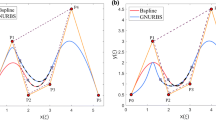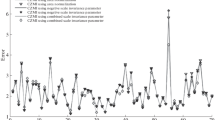Abstract
Implicit polynomials (IPs) are applied to represent 2D object shapes in image processing and computer vision. However, it is difficult for IPs to represent complex object shapes due to high computational cost and high instability. In this work, we present a new representation model based on IPs, which is called fractional implicit polynomial (FIP). Firstly, the general formula for FIP and a definition of base are given; secondly, we investigate the properties of FIPs and conclude that the FIP representation exhibits higher stability and higher power than IP representation due to the presence of the base. Thirdly, we develop an algorithm for determination of a moderate degree for an FIP to represent a given shape, which can be obtained by only computing the number of stationary points on the shapes. We compare FIPs with IPs by test on various object shapes and the results show that the FIP is indeed sufficiently powerful to represent the complex object shapes.













Similar content being viewed by others
References
Abjyankar, S.: Algebraic Geometry for Science and Engineers. American Mathematical Society, Providence (1990)
Ben, H.: 3d objects description and classification by implicit polynomials. M.Sc. thesis, The Technion Israel Institute of Technology, Haifa (2008)
Ben, H., Malah, D., Barzohar, M.: Recognition of 3d objects based on implicit polynomials. IEEE Trans. Pattern Anal. Mach. Intell. 22(7), 663–674 (2010)
Binder, H., Sauerbrei, W., Royston, P.: Comparison between splines and fractional polynomials for multivariable model building with continuous covariates: a simulation study with continuous response. Stat. Med. 32(13), 2262–2277 (2013)
Blane, M., Lei, Z.: The 3L algorithm for fitting implicit polynomial curves and surfaces to data. IEEE Trans. Pattern Anal. Mach. Intell. 22(3), 298–313 (2000)
Carr, J., Beatson, R., Cherrie, J., Mitchell, T., Fright, W., McCallum, B.: Reconstruction and Representation of 3d Objects with Radial Basis Functions. In: SIGGRAPH, pp. 67–76 (2001)
Heizer, A., Barzohar, M., Malah, D.: Stable fitting of 2d curves and 3d surfaces by implicit polynomials. IEEE Trans. Pattern Anal. Mach. Intell. 26(10), 1283–1294 (2004)
Helzer, A., Zohar, M.B., Malah, D.: Using Implicit Polynomials for Image Compression. In: Proceedings of IEEE Conference on Convention of the Electrical and Electronic Engineers, pp. 384–388 (2000)
Jaroslav, K., Flusser, J.: Implicit Invariants and Object Recognition. In: Proceedings of the 9th Biennial Conference of the Australian Pattern Recognition Society on Digital Image Computing Techniques and Applications, pp. 462–469 (2007)
Kazhdan, M., Hoppe, H.: Screened Poisson surface reconstruction. ACM Trans. Graph. (TOG) 32(3), 29 (2013)
Keren, D., Cooper, D.: Describing complicated objects by implicit polynomial. IEEE Trans. Pattern Anal. Mach. Intell. 16(1), 38–53 (1994)
Keren, D., Gotsman, C.: Fitting curves and surfaces with constrained implicit polynomials. IEEE Trans. Pattern Anal. Mach. Intell. 21(1), 31–41 (1999)
Landa, Z.: 2d object description and classification based on contour matching by implicit polynomials. M.Sc. thesis, The Technion Israel Institute of Technology, Haifa (2006)
Lebmeir, P., Gebert, J.: Rotations translations and symmetry detection for complexified curves. Comput. Aided Geom. Des. 25(9), 707–719 (2008)
Marola, G.: A technique for finding the symmetry axes of implicit polynomial curves under perspective projection. IEEE Trans. Pattern Anal. Mach. Intell. 27(3), 465–470 (2005)
Oden, C., Ercil, A., Yildiz, V., Kirmiztia, H., Buke, B.: Hand Recognition Using Implicit Polynomials and Geometric Features. Springer Lecture Notes in Computer Science, vol. 2091, pp. 336–341. Springer, Berlin (2001)
Rouhani, M., Sappa, A.: Implicit polynomial representation through a fast fitting error estimation. IEEE Trans. Image Process. 21(4), 2089–2098 (2012)
Rouhani, M., Sappa, A., Boyer, E.: Implicit b-spline surface reconstruction. IEEE Trans. Image Process. 24(1), 22–32 (2015)
Royston, P., Sauerbrei, W.: Improving the robustness of fractional polynomial models by preliminary covariate transformation: a pragmatic approach. Comput. Stat. Data Anal. 51(9), 4240–4253 (2007)
Subrahmonia, J., Cooper, D., Keren, D.: Practical reliable Bayesian recognition of 2d and 3d objects using implicit polynomials and algebraic invariants. IEEE Trans. Pattern Anal. Mach. Intell. 18(5), 505–519 (1996)
Tarel, J., Cooper, D.: The complex representation of algebraic curves and its simple exploitation for pose estimation and invariant recognition. IEEE Trans. Pattern Anal. Mach. Intell. 22(7), 663–674 (2000)
Tasdizen, T., Cooper, D.: Boundary estimation from intensity color images with algebraic curve models. In: Proceedings of 15th International Conference on Pattern Recognition, pp. 225–228 (2000)
Tasdizen, T., Tarel, J.: Improving the stability of algebraic curves for application. IEEE Trans. Image Process. 9(3), 405–416 (2000)
Taubin, G., Cukirman, F., Sullivan, S.: Parameterized families of polynomials for bounded algebraic curve and surface fitting. IEEE Trans. Pattern Anal. Mach. Intell. 16(3), 286–303 (1994)
Wu, G., Li, D.: Object recognition based on affined invariants in implicit polynomial curves. Acta Electron. Sin. 32(12), 1987–1991 (2004)
Wu, G., Yang, J.: A representation of time series based on implicit polynomial curve. Pattern Recogn. Lett. 34(4), 361–371 (2013)
Yasin, A., Calli, B., Unel, M.: Image based visual servoing using algebraic curves applied to shape alignment. In: Proceedings of IEEE International Conference On Intelligent Robots and Systems, pp. 5444–5449 (2009)
Zheng, B., Ishikawa, R., Oishi, T., Takamatsu, J., Ikeuchi, K.: A fast registration method using IP and its application to ultrasound image registration. IPSJ Trans. Comput. Vis. Appl. 1, 209–219 (2009)
Zheng, B., Takamatsu, J., lkeuchi, K.: An adaptive and stable method for fitting implicit polynomial curves and surfaces. IEEE Trans. Pattern Anal. Mach. Intell. 32(3), 561–567 (2010)
Acknowledgments
This work was supported in part by the National Natural Science Foundation of China (NSFC) under Grants 71372188 and National Center for International Joint Research on E-Business Information Processing under Grant 2013B01035.
Author information
Authors and Affiliations
Corresponding author
Rights and permissions
About this article
Cite this article
Wu, G., Zhang, Y. A Novel Fractional Implicit Polynomial Approach for Stable Representation of Complex Shapes. J Math Imaging Vis 55, 89–104 (2016). https://doi.org/10.1007/s10851-015-0615-7
Received:
Accepted:
Published:
Issue Date:
DOI: https://doi.org/10.1007/s10851-015-0615-7




